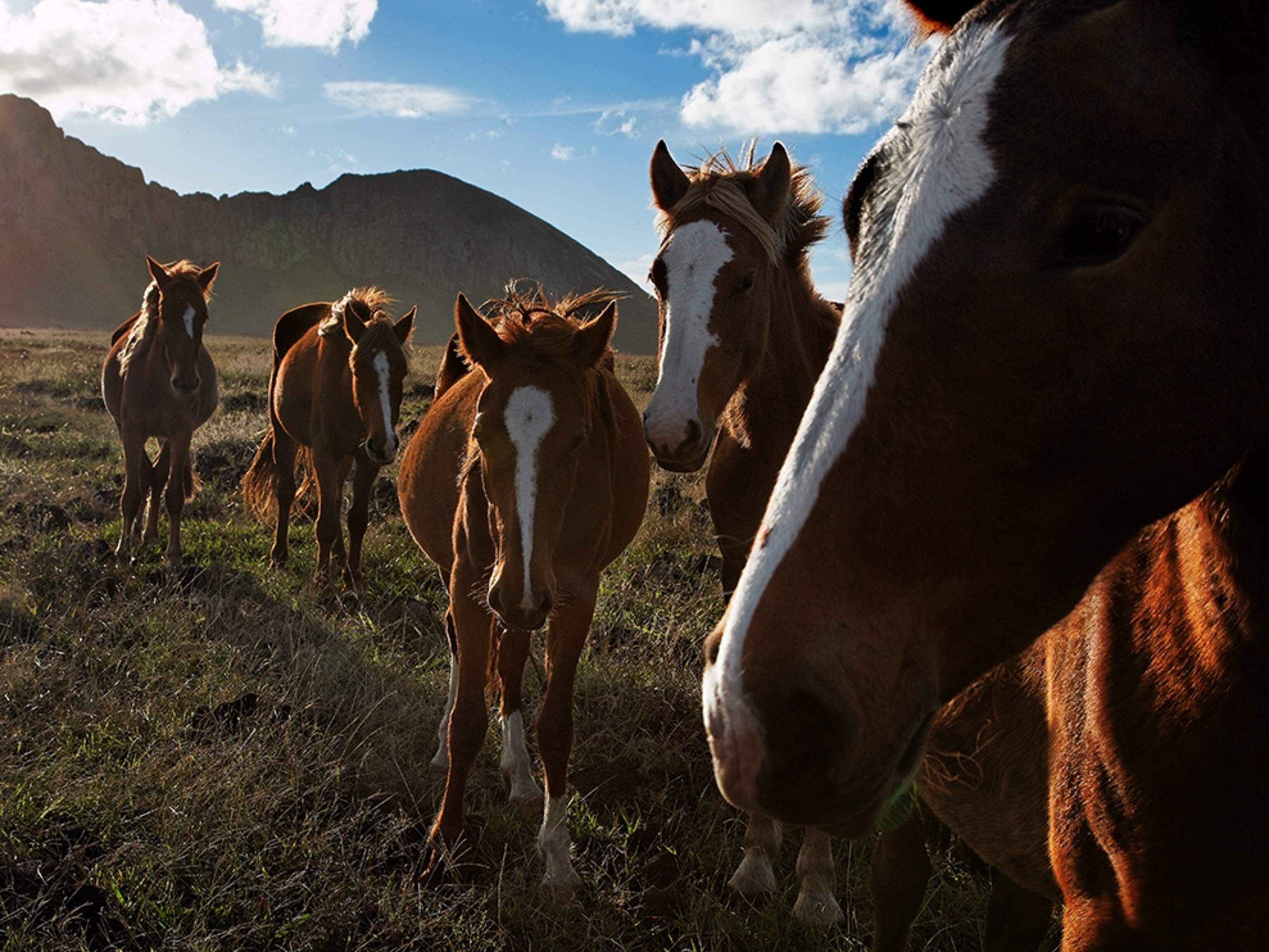Discover the Mysteries of Easter Island
The isolated Rapa Nui developed a distinct architectural and artistic culture that weathered the centuries.
Rapa Nui’s mysterious moai statues stand in silence but speak volumes about the achievements of their creators. The stone blocks, carved into head-and-torso figures, average 13 feet (4 meters) tall and 14 tons. The effort to construct these monuments and move them around the island must have been considerable—but no one knows exactly why the Rapa Nui people undertook such a task. Most scholars suspect that the moai were created to honor ancestors, chiefs, or other important personages, However, no written and little oral history exists on the island, so it’s impossible to be certain.
A Polynesian society blossomed in this unlikely locale after hardy souls somehow navigated a fleet of wooden outrigger canoes to this tiny speck in the vastness of the Pacific Ocean. Here, in isolation some 2,300 miles (3,700 kilometers) west of South America and 1,100 miles (1,770 kilometers) from the nearest neighboring island, the Rapa Nui developed a distinct architectural and artistic culture. That culture reached its zenith during the tenth to 16th centuries, when the Rapa Nui carved and erected some 900 moai across the island.
It is generally thought that the Rapa Nui’s demise resulted from an environmental catastrophe of their own making.
It’s not clear when the islands were first settled; estimates range from A.D. 800 to 1200. It’s also not clear how quickly the island ecosystem was wrecked—but a major factor appears to be the cutting of millions of giant palms to clear fields or make fires. It is possible that Polynesian rats, arriving with human settlers, may have eaten enough seeds to help to decimate the trees.
Either way, loss of the trees exposed the island’s rich volcanic soils to serious erosion. When Europeans arrived in 1722, they found the island mostly barren and its inhabitants few.
Today’s tourists are numerous, and most visit the Rano Raraku quarry, which yielded the stones used for almost all of the island’s moai. Rapa Nui’s ancient inhabitants left the quarry in a fascinating condition—it is home to some 400 statues, which appear in all stages of completion.
Meanwhile, across the entire island, many moai are reversing the creation process and deteriorating rapidly from priceless carvings back into plain rock. The volcanic stone is subject to weathering, and intensive conservation efforts are needed to help preserve Rapa Nui’s stone legacy in its present, awe-inspiring state.







How to Get There
It’s miraculous that Polynesian peoples ever reached Rapa Nui in the first place. Getting there today is far easier, but the island is still very far afield. Long flights service Rapa Nui from Santiago, Chile and Tahiti.
When to Visit
High season on Rapa Nui is the Southern Hemisphere summer—January to March. Though winter can get a bit chilly, average maximums still hover around 72ºF (22ºC) and minimums dip to only 57ºF (14ºC)—so the weather is really rather pleasant year-round. Reduced crowds are an added attraction in the off-season.
How to Visit
Cars, motorcycles, and mountain bikes are available for hire and all are good ways for visitors to explore the island’s scattered archaeological sites. While most people visit Rapa Nui to explore its cultural history the island is also home to some excellent diving, surfing, and enticing beaches when a bit of relaxation is in order.

Related Topics
You May Also Like
Go Further
Animals
- How can we protect grizzlies from their biggest threat—trains?How can we protect grizzlies from their biggest threat—trains?
- This ‘saber-toothed’ salmon wasn’t quite what we thoughtThis ‘saber-toothed’ salmon wasn’t quite what we thought
- Why this rhino-zebra friendship makes perfect senseWhy this rhino-zebra friendship makes perfect sense
- When did bioluminescence evolve? It’s older than we thought.When did bioluminescence evolve? It’s older than we thought.
- Soy, skim … spider. Are any of these technically milk?Soy, skim … spider. Are any of these technically milk?
Environment
- Are the Great Lakes the key to solving America’s emissions conundrum?Are the Great Lakes the key to solving America’s emissions conundrum?
- The world’s historic sites face climate change. Can Petra lead the way?The world’s historic sites face climate change. Can Petra lead the way?
- This pristine piece of the Amazon shows nature’s resilienceThis pristine piece of the Amazon shows nature’s resilience
- Listen to 30 years of climate change transformed into haunting musicListen to 30 years of climate change transformed into haunting music
History & Culture
- Meet the original members of the tortured poets departmentMeet the original members of the tortured poets department
- Séances at the White House? Why these first ladies turned to the occultSéances at the White House? Why these first ladies turned to the occult
- Gambling is everywhere now. When is that a problem?Gambling is everywhere now. When is that a problem?
- Beauty is pain—at least it was in 17th-century SpainBeauty is pain—at least it was in 17th-century Spain
Science
- Here's how astronomers found one of the rarest phenomenons in spaceHere's how astronomers found one of the rarest phenomenons in space
- Not an extrovert or introvert? There’s a word for that.Not an extrovert or introvert? There’s a word for that.
- NASA has a plan to clean up space junk—but is going green enough?NASA has a plan to clean up space junk—but is going green enough?
- Soy, skim … spider. Are any of these technically milk?Soy, skim … spider. Are any of these technically milk?
Travel
- This tomb diver was among the first to swim beneath a pyraamidThis tomb diver was among the first to swim beneath a pyraamid
- Dina Macki on Omani cuisine and Zanzibari flavoursDina Macki on Omani cuisine and Zanzibari flavours
- How to see Mexico's Baja California beyond the beachesHow to see Mexico's Baja California beyond the beaches
- Could Mexico's Chepe Express be the ultimate slow rail adventure?Could Mexico's Chepe Express be the ultimate slow rail adventure?




